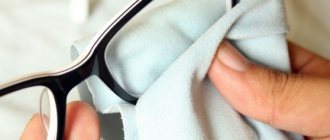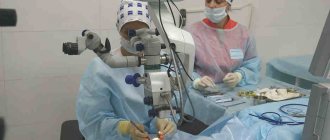Diplopia is a visual impairment in which a person often sees double. The development of such a deviation can be caused by various factors, and it occurs due to the image falling not on the central zone, but on other areas of the retina. Let's consider what diplopia is and is it possible to get rid of this eye disease?
Causes of diplopia
The appearance of such a pathology can be provoked by various factors: ophthalmological, infectious, neurological. For example, double vision can occur after eye injuries, when the axis of the eyeball is displaced as a result of an impact. Diplopia can result from damage to the optic nerve due to intracranial tumors.
This disorder is also noted during infectious processes: rubella, mumps, when the brain stem is affected. Even strong alcohol consumption can cause diplopia—drunk people often see double—or drug intoxication. Image displacement is also observed in botulism, multiple sclerosis, and thyrotoxicosis. Diplopia can also be a type of complication after eye surgery.
Optical correction of ametropia
It is necessary to distinguish between the direct effect of glasses on visual acuity and visual performance - the “tactical” effect of optical correction, as well as their influence on the dynamics of refraction and some painful conditions of the eye (asthenopia, pseudomyopia, amblyopia, strabismus) - the strategic effect of optical correction, with the second effect in to a certain extent is realized through the first.
When examining a patient, in order to prescribe glasses, the doctor solves two closely related problems:
- determines the static refraction of each eye;
- determines the required optical correction, which depends on the state of static and dynamic refraction, the age of the patient, monocular and binocular tolerance of glasses, as well as indications for their use.
The following examination procedure is advisable:
- determine the visual acuity of each eye;
- carry out a test with plus and minus spherical lenses to roughly determine the type and degree of ametropia; a significant increase in visual acuity will indicate, in addition, a predominantly refractive reason for its deterioration;
- prescribe medications that relax accommodation;
- determine refraction in conditions of cycloplegia;
- in conditions of cycloplegia, the visual acuity of each eye is checked with lenses (without using a diaphragm) that completely correct ametropia; in conditions of cycloplegia with these lenses, visual acuity should be (maximum);
- after the effect of the cycloplegic drug has ended, based on the results of the previous stage of the examination, the general rules for prescribing glasses for various types of ametropia and trial wearing glasses for 15 - 30 minutes (reading, walking, moving the gaze from one object to another, moving the head and eyes ) finally resolve the issue of rational optical correction. This takes into account the good binocular portability of glasses for both distance and near.
Preschool children, as well as children with amblyopia, are prescribed glasses only based on the results of an objective determination of refraction in conditions of cycloplegia.
| Type of ametropia | Clinical features | Correction |
| Farsightedness (hyermetropia) | Absence of asthenopic complaints, visual acuity for each eye not lower than 1.0, stable binocular vision | Not prescribed |
| Hyperopia more than 3.5 diopters in young children | Glasses for constant wear. If there is no tendency to strabismus or amblyopia at the age of 6-7 years, they can be canceled. | |
| Asthenopic complaints or decreased vision in at least 1 eye, regardless of the degree of hypermetropia | Constant, according to subjective tolerability, with a tendency towards maximum correction of ametropia. | |
| Persistent or periodic convergent strabismus | Constant, as a rule, is 1.0 diopters less than the degree of hypermetropia detected in conditions of cycloplegia. | |
| Permanent or periodic divergent strabismus | Prescribed only in cases where visual acuity without glasses is reduced to 0.6-0.7 or less. | |
| Myopia (myopia) | Low or medium
|
|
High degree
|
| |
| Astigmatism | All types | Constant, the strength of astigmatic glasses is determined depending on tolerance, the strength of spherical glasses is determined according to the rules outlined above |
| Anisometropia | Constant, according to subjective tolerability |
Prescribing glasses for farsightedness. Indications for the prescription of glasses for farsightedness are asthenopic complaints or decreased visual acuity in at least one eye. In such cases, as a rule, permanent optical correction is prescribed depending on subjective tolerability with a tendency towards maximum correction of ametropia. If such correction does not bring relief in asthenopia, then stronger glasses (by 1.0-2.0 diopters) are prescribed for visual work at close range. With small degrees of farsightedness and normal visual acuity, you can limit yourself to prescribing glasses for working only at close range.
For young children (2-4 years old) with farsightedness of more than 3.5 diopters, it is advisable to prescribe glasses for constant wear that are 1.0 diopters weaker than the degree of ametropia. In such cases, the meaning of optical correction is to eliminate the conditions for the occurrence of accommodative strabismus. If by the age of 6-7 years the child retains stable binocular vision, visual acuity without glasses does not decrease and he does not experience asthenopic difficulties, then optical correction is canceled.
Prescribing glasses for myopia. For low and moderate distance myopia, full correction is usually recommended. The rules of optical correction for near are determined by the state of accommodation. If it is weakened (changes in the ergogram, a decrease in the reserve of relative accommodation, visual discomfort when reading with glasses), then a second pair of glasses is prescribed for working at close range or bifocal glasses for constant wear. The upper half of these glasses is used for distance vision and is equipped with glasses that completely or almost completely correct myopia; the lower half of the glasses, designed for working at close range, is weaker than the upper by 2.0, 3.0 or 4.0 diopters, depending on subjective sensations child and degree of myopia. The higher it is, the usually greater the difference in the strength of glasses intended for distance and near. This is a passive method of optical correction of myopia.
In order to increase the accommodative ability of the myopic eye, special exercises are performed for the ciliary muscle. If this ability is consistently normalized, complete or almost complete optical correction is prescribed and, for working at close range, an active method of myopia correction. In these cases, the glasses will encourage accommodation to become active.
Prescription of glasses for astigmatism and anisometropia. For astigmatism of all types, constant wearing of glasses is indicated. The astigmatic correction component is prescribed depending on subjective tolerance with a tendency to complete correction of astigmatism. The spherical component of the correction is prescribed in accordance with the general rules for prescribing glasses for farsightedness and myopia.
For anisometropia, permanent optical correction is prescribed, taking into account the subjectively tolerable difference between the strength of the corrective glass of the right and left eyes. Young children tolerate glass differences of up to 5.0 diopters well. Usually, optical correction of anisometrosis is better tolerated for distance than for near, so the difference in the strength of glasses for distance may be slightly greater than for near.
Purpose of prismatic correction . In case of decompensated exophagia for near, combined with insufficiency of accommodation, prismatic correction elements, in particular bifocal spheroprismatic glasses (BSPO), can be prescribed.
Treatment of diplopia
Many patients with this disorder ask the question: is it possible to get rid of such unpleasant manifestations forever? After all, diplopia interferes with many types of activities - it is impossible to work with documents or at a computer, or drive a car. Ophthalmologists say that diplopia can be cured, but a successful result depends very much on the cause that caused this eye pathology. In modern ophthalmology, several methods are used.
Features of application
Schneider's development turned out to be so necessary and useful that its creator received a prestigious award in one of the international competitions. You can put on prismatic glasses without even removing the regular optics with diopters that you wear for vision correction.
Prismatic glasses will be needed for those who professionally engage in rock climbing, industrial mountaineering, often visit artificial climbing walls, and are fond of tourism. These glasses can be purchased at many retail and online sporting goods stores. They are usually sold in a convenient durable case and come complete with a soft cloth designed for wiping glass.
Typically, the frame of these glasses is made of durable polycarbonate material and thermoplastic polyurethane, and the lenses are made of mineral glass. The design feature of prismatic glasses with thick lenses is reflected in the overall weight of the product. Compared to regular frames, sports glasses are quite massive and heavy. To make them sit more comfortably on the face, they are equipped with rubber nose pads and a fixing tape. In the latest models, manufacturers have lightened the design by using less plastic, which makes climbing glasses more convenient and comfortable.
MagazinLinz.ru team
Surgery
If the pathology is caused by disturbances in the functioning of the visual organs after injuries or in other cases, then surgical intervention is used to radically solve the problem. There are two ways:
- Recession of the eye muscle is its weakening through movement.
- Resection of a muscle is a reduction in its length.
The same operations are performed in the treatment of strabismus. They have been practiced in ophthalmology for several decades and show effective results.
Options for correcting congenital strabismus
It is believed that strabismus (congenital strabismus) cannot be eliminated. However, it is quite possible to improve the quality of life. The main task is to choose the right glasses for strabismus, which can cope with the existing disorders.
The method of treating strabismus with glasses is especially suitable for children. This method involves correction after a thorough study of the pathology and structural features of the eye.
The effectiveness of treating strabismus with glasses is not always high, and this is worth remembering. Most often, it is not possible to get rid of the defect without surgery; the kidneys act as only one of the possible measures.
To improve the quality of vision, cylindrical-spherical glasses are usually prescribed. If the strabismus is non-accommodative or partially accommodative, the patient is prescribed Fresnel prisms, which are installed on the lenses of glasses. The selection of prisms is carried out individually, taking into account the child’s vision characteristics.
The appointment can only be made by an ophthalmologist. This takes into account the decrease in the quality of vision. Most often, prisms are used in the treatment of paralytic strabismus. Prismatic glasses have virtually no weight, so their installation does not bring additional discomfort. Glasses require regular care. If the prism comes off, you should consult a doctor again.
Functional treatment
A way to get rid of double vision by performing special exercises. This is a well-known technique of doctor T.P. Kashchenko to restore binocularity and expand the field of view - connecting images using repeating sequential images. Such exercises can be done at home on your own or in a hospital.
To summarize, we can say: diplopia can be cured, it all depends on the correct identification of its cause and proper therapy.
What role do glasses play in correcting strabismus?
Competent selection of glasses should be based on existing vision problems and correct diagnosis. Timely consultation with a doctor will help avoid further deterioration in the quality of vision.
Before prescribing glasses for strabismus, a specialist will conduct a detailed study and prescribe a series of studies that will help identify all the features of the child’s vision.
It is important to devote as much time as possible to this stage and approach it with all responsibility, since only well-chosen glasses can give the maximum effect.
Today, experts are increasingly prescribing special glasses that improve vision in case of strabismus. However, in some cases they suggest replacing wearing a bandage with a special lens. It is no secret that because of strabismus, people develop psychological problems and complexes, and the bandage also contributes to their appearance. The lens, offered instead of a bandage, has a special substrate on which an image of the eye is created. However, this is also unaesthetic, so the patient can choose for himself what is more acceptable to him.









